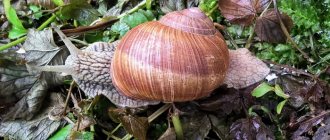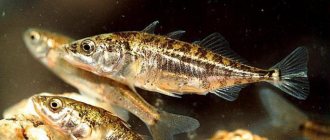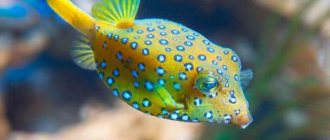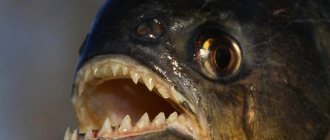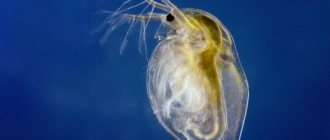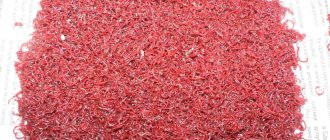The larva is one of the first phases of mosquito development. Fishermen call them bloodworms. They are often kept as fish food. Another name for this phase of the cycle is the squeak mosquito. Outwardly, they look like worms, and are distributed mainly at the bottom of containers and reservoirs. The bloodworm is slightly different from the traditional concept of a larva, although it is included in this list: it has a bright red color because its blood contains a large amount of hemoglobin.
Mosquito larva under a microscope
Description and classification of larvae
A mosquito larva is a bloodworm. Typically, the coloring of these insects may depend on the type/species of the insect. The following representatives of this species can be distinguished:
What to do in such a situation? To get started, we recommend reading this article. This article describes in detail methods of controlling parasites. We also recommend that you consult a specialist. Read the article >>>
- Squeak mosquito - its larvae are brown or black;
- Malaria mosquitoes are green;
- Bell bell larvae have a red color palette.
When emerging from eggs, their size is only 2 mm, but then individuals grow up to 1 cm. Two eyes can be seen on the body, as well as a special tube with which new organisms are able to breathe. They move through the water with the help of special hairs located along the body. Breathing occurs with the help of raised tails - they capture oxygen from the atmosphere and then set off on their further journey.
The structure and appearance of mosquito larvae
If we consider the appearance of the larvae, then at first glance we can describe them as small worms, which in size do not exceed 1 cm. However, by certain features we can accurately determine that this is a mosquito larva:
Appearance of the larva
- Wider thoracic region, when compared with the articulated abdomen;
- 2 black eyes on the head;
- The corresponding color of their variety;
- The long process, which is located obliquely in relation to the abdomen, is a breathing tube through which the larva receives the oxygen it needs into the body.
Movement is carried out with the help of special swimming hairs: you can clearly see this process if you approach a body of water and then sharply move your hand over the surface of the water. The larvae will immediately scatter in different directions and will strive to go deeper.
Nutrition and lifespan of mosquito larvae
As a larva, a mosquito can live for 3-4 weeks: the ambient temperature plays a major role here, as well as other external factors. During this period, the larva molts several times, gets rid of the exoskeleton and becomes several times larger. For normal development of the larvae, a temperature of 10-25 degrees is sufficient, and the ideal indicator is 25-30 degrees.
As food, they use nutrients from microorganisms and small living creatures that live in bodies of water. This can be plant organic matter or unicellular algae. With the help of a water filtration mechanism, an individual can pass through itself about 1 liter per day. After this, the mosquito begins to turn into a pupa - this is a more complex creature that precedes the appearance of a full-fledged individual.
Bloodworm breeding
To breed bloodworms at home, no special container is required; just take any bucket, basin or plastic container. The larvae are kept in a low layer of silt up to 2 cm high, above which there is a layer of water of several mm, which increases the oxygen content in the silt. This creates safe conditions for the larvae to live. The optimal room temperature will be 18-20 degrees, otherwise development will not go well. It should be remembered that too much water above the sludge impairs the oxygen supply to the larvae and can cause their death.
It is not difficult to obtain silt; you can take it from the bottom of any reservoir, pour boiling water at home to sterilize it, and then, after settling the silt, drain the boiling water. After this, the sludge is poured with cold water and mixed with nutritional yeast in a ratio of 99:1 to give the sludge the consistency of sour cream. After this, the sludge can be placed in a container; after a while, a layer of water forms above the sludge.
After this, masonry can be placed in the silt. During the period of mass mosquito breeding, sticky clutches of bloodworms become entangled in fishing nets and other substrates. The yeast we dissolved is enough to feed the larvae for 10-12 days, after which they should be fed with dry pureed yeast. It is enough to evenly sprinkle 40 g of yeast per 1 square meter. m. After 16-18 days, the larvae will be ready to be hooked or fed to fish. They can be caught in a sieve and washed.
Respiratory system of mosquito larvae
As mentioned above, for breathing the larvae use a breathing tube, which is located on their body in the form of a long process. The breathing process is different from most living creatures: the larva must swim to the edge of the reservoir and bring it to the surface - thus, oxygen enters the body. This system is characteristic of common mosquitoes.
There are also some species of mosquitoes that breathe using dissolved oxygen. They absorb it using the entire surface of their body. Since they do not need to surface to do this, they most often live in deep areas of water bodies. For those individuals that live at the bottom of the reservoir, special gill threads are provided, which provide them with a sufficient amount of oxygen.
Extraction methods
This bait can be purchased ready-made in a specialized store. However, you can get it for free. But you will have to try hard for this.
Bloodworms love silt, but are afraid when it heats up and disintegrates, as the amount of oxygen suitable for life decreases. Therefore, you can bring a bucket of sludge home and put it on the stove to heat it. Subsequently, the bloodworm itself will swim to the net.
Message from Nick-Nick
Developmental process of mosquito larvae
The development of the insect begins from the moment the female lays the first batch of eggs. The most optimal place for it is ponds, puddles and other places with high levels of humidity - which is why mosquito larvae first live in water, where they feed on various plants and microorganisms that live on the surface. At first, the larva can be no more than 1 mm in length.
The structure of the larva is very different from that of the adult. At the first stage, the larvae are quite active, so signs of their presence can be seen on the surface of the reservoir and swamps. With the help of a breathing tube they are sucked to the surface. With the help of the peculiarities of their structure, the larvae manage to safely survive the first stage of their development.
Notes
Wikimedia Foundation. 2010.
See what “Motyl” is in other dictionaries:
Motyl-Ky - Motyl Ky: Rivers Motyl-Ky (Taza basin) Motyl-Ky (tributary of the Weyarmolka) Motyl-Ky (tributary of the Kanyl-Ky) Motyl-Ky (tributary of the Chaselki) ... Wikipedia
Bloodworms are the larvae of a number of species of bell-bellied mosquitoes, mainly. genus (Chironomus). They live in the silt of standing and slowly flowing eutrophic reservoirs. Dl. up to 25 mm, the body is narrow, cylindrical, with a sclerotized head and 2 pairs of false legs on the anterior and posterior... ... Biological encyclopedic dictionary
bloodworm - larva, bait Dictionary of Russian synonyms. bloodworm noun, number of synonyms: 4 • crank (3) • larva... Dictionary of synonyms
MOTYL - Vladimir Yakovlevich (born 1927), director. In 1948 57 he worked in theaters in the Urals and Siberia. Since 1963 in cinema. Motyl's penchant for an eccentric and tragicomic interpretation of the material manifested itself in the films: Zhenya, Zhenechka and Katyusha (1967), White Sun... ...Modern Encyclopedia
BORLOWS - Bloodworms are the worm-like dark red larvae of bell-bellied mosquitoes. Length up to 25 mm. They live in the mud of lakes and ponds. Food for fish, including aquarium fish; used as bait for sport fishing... Modern encyclopedia
Bloodworms are worm-like dark red larvae of bell-bellied mosquitoes. Length up to 25 mm. They live in the mud of lakes and ponds. Nutritious food for fish, including aquarium fish, used as bait for sport fishing... Big Encyclopedic Dictionary
Bloodworms are worm-like dark red larvae of bell-bellied mosquitoes. Length up to 25 mm. They live in the mud of lakes and ponds. Nutritious food for fish, including aquarium fish, used as bait for sport fishing... Big Encyclopedic Dictionary
Bloodworms are worm-like dark red larvae of bell-bellied mosquitoes. Length up to 25 mm. They live in the mud of lakes and ponds. Nutritious food for fish, including aquarium fish, used as bait for sport fishing... Big Encyclopedic Dictionary
Life cycle of a larva
At this stage, an individual can survive for several weeks - it all depends on specific environmental factors (temperature, what is contained in the water, food, etc.) If the larva is in warm living conditions, then it develops much faster - it increases in size size and reaches 8-10 mm. If mosquitoes were born in winter, then the process slows down several times.
During development, the larva begins to increase in size - the volume of its body becomes 500 times larger (however, its wings and limbs have not formed). In order for the creature to grow at such a rapid pace, nature endowed them with the ability to get rid of the exoskeleton. To reach the optimal size, the larva has to molt about 4 times during the entire cycle - with the passage of each stage it becomes a more complex organism.
Feeding mode of mosquito larvae
In order for the larva to actively develop, it needs a suitable ambient temperature. It should vary between 10-35 degrees: it is better if it is between 25-30 degrees. While the development process is underway, the weight and length of the larva begins to actively increase.
As a source of nutrition, the creature uses microorganisms that are present in the reservoir at that moment. Usually these are simple algae, as well as decaying organic matter. To provide itself with the necessary nutrients, the larva uses a filtration process - about 1 liter of water passes through it within one day. It then enters the pupal stage to form an adult organism.
Habitat of larvae
All types of mosquitoes in this regard are similar in one thing - they choose the place for laying eggs with special care. It is very important that the development cycle took place in the most favorable conditions for the individuals. That is why several factors are considered here when searching for such a place: illumination of the area, availability of freely available nutrients, suitable water temperature.
To give birth to a new generation, the female chooses small standing ponds. For the transition to the next pupal stage, as well as the development of individuals, constant access to nutrients is necessary, which in the first stages can be found in water. At the same time, females rarely pay attention to large bodies of water - here there is a high probability of encountering a predator. Also, if the water is too dirty, the larvae will quickly die.
Where and how do larvae develop?
As noted earlier, the larva can exist in this phase for several weeks. This stage determines the further development of the insect, since at this stage the foundation is laid for organs and body parts, which later play an important role in the development of a full-fledged individual. Several factors influence further development and speed of formation:
- Temperature conditions;
- Water and its quality (composition);
- Sufficient amount of nutrients in the reservoir;
- Illumination of the habitat.
Reservoirs with stagnant water and optimal temperature at depth (at least 10 degrees Celsius) are best suited for development. With these factors, growth occurs much faster. At this stage, the insect can expand up to 10 times its length.
Where is the best place for larvae to live?
The best life is for the larvae that live in swampy areas, whirlpools and muddy ponds. A large number of microorganisms can be found here. Which are perfect for feeding - they reproduce at a high rate, which means that the larvae will always find something to eat here.
If the water is absolutely clean, then this can cause some difficulties for the mosquitoes living there - due to their color, they will become a visible bait for predators. Moreover, in such reservoirs there are a large number of creatures that feed on mosquitoes (water bugs, beetles and swimming beetles). Fish and birds also pose a great danger to these insects. Here mosquitoes have to look for a middle ground: in crystal clear waters they are exposed to danger, but even with heavy household pollution they simply may not survive.
Nutritional properties
Bloodworms are superior to all known types of food, but if you overdo it, the fish begins to get fat. The high content of vitamin A, carotene, and B vitamins allows the fish to eat well during the spawning period. If such food is abused and fish are fed to their fill, representatives of the ichthyofauna experience a disruption in the functioning of the gastrointestinal tract, accompanied by poisoning, which subsequently leads to sudden death (this happens in 30% of cases). This effect develops due to the difficulty of etching the bloodworms. Therefore, you need to feed the fish with such a nourishing supplement in moderation.
Living conditions for mosquito larvae
It all depends on the specific type of mosquito: some species prefer to live in hot and warm climates (tropical forests), while others find it easiest to live within the Arctic Circle. Some species prefer reservoirs that are well warmed up by the sun's rays, while others, on the contrary, look for more shady areas. The optimal temperature for the development and reproduction of all species is 10-35 degrees. In this case, the growth of the larvae and their transition to the next state occurs faster.
Dangerous environment for larvae
A large number of larvae die - only a small part of them moves on to the next stage of pupal formation. The reasons for such rapid death may be the following:
- Low water temperature;
- Natural disasters;
- A large number of predators.
All losses of larvae are compensated by the fertility of adults, so their number on average remains stable. The most common cause of death of larvae is an attack by fish and other inhabitants of water bodies, for which they are a delicacy. The larvae have no additional means of defense in this case.
Another problem they have to face is the environmental situation in the reservoir. If there is a high concentration of petroleum products in the water, then the surface is covered with a thin film, which can block access to oxygen. The larva dies within 15 minutes because the oil also clogs the holes in the breathing tube.
Feeding aquarium fish
Bloodworms have always been considered the best live food for adult fish. When purchasing this food, you must carefully inspect it. It should be red, but not scarlet. Bright red bloodworms usually do not last long. It should be elastic, move when touched and lie separately, curl into a ring.
You cannot feed dead bloodworms to fish, as they can easily be poisoned. Freshly caught fish are also not suitable for feeding fish. It is necessary to withstand it for 2-4 days to cleanse the intestines, which may contain pathogenic flora of local reservoirs. During this period, the water in which the larvae are located must be changed periodically.
Store it in a cool place at a temperature of 4-8°C, for example in the refrigerator. If you have a large amount of bloodworms that cannot be kept alive for long, you can freeze them. The best way to do this is to spread it in a thin layer on plastic film, to which it does not stick. When it freezes, break the resulting pancake into pieces, put it in a plastic box and put it in the freezer.
It is recommended to feed adult aquarium fish with bloodworms using a floating feeder with holes in the bottom, through which live bloodworms gradually crawl into the water. This does not give him the opportunity to bury himself immediately in the ground. But my fish caught buried bloodworms and even pupae that emerged before the mosquitoes appeared. I did not like the recommendations to feed small aquarium fish and grown juveniles with bloodworms cut with scissors on glass. Everything flows out of the bloodworm, leaving only skins that are of no value. But this method works with the tubifex.
Video
Types of mosquito larvae
Mosquitoes are divided into several subspecies, which are characterized by a special appearance, structure and behavior. Most often in wildlife you can find the following varieties:
- Malaria mosquitoes - they are characterized by a large head, large chest and segmented abdomen. A distinctive feature is the absence of a breathing tube. Instead, there are spiracles on the body. Their habitat is the surface of the water. They feed on small microorganisms.
- Mosquitoes - jerks. Most often, they are caught by fishermen for fishing. They are also purchased for feeding aquarium fish. In another way, they are called bloodworms, and you can buy them in any store (both fresh and frozen).
- Centipedes - they can be found in swampy areas. A distinctive feature is the tufts that are located at the base of the body.
- Pedicius - have false legs that allow them to move along the bottom of reservoirs. They can survive even in contaminated sources. Etc.
Malarial
Malaria mosquitoes can be identified by the structural features of their body. They are characterized by a large head with oral brushes for feeding, a large chest and an abdomen that consists of several parts. Special spiracles are located in the 8th segment of the body and are an excellent replacement for the breathing tube. They try to stick to the surface of the water - most often they stand parallel to it. Here they live quietly, feed, catch small insects and microorganisms, and then immediately send them into their mouths.
centipedes
Centipedes hatch from eggs that were previously laid in swampy areas. They are comfortable growing near rotten plants, roots, tree bark and silt. If you look at their appearance, they look like gray-brown worms with a large head, and on the back of their abdomen there are spiracles, which are surrounded by meat growths. The star-shaped mouthparts are located at the end of the body.
Mosquito jerk
Experts say that this type of “bloodworm” has become an intermediate stage between the jerk and the bell. They are often purchased by fishermen to use as bait. Usually the size of these larvae does not exceed 2-3 cm, and they also have a characteristic red color. They prefer to choose the bottom of reservoirs, dense thickets or silt as permanent housing. In such territory they obtain their food. However, they need to periodically float up to fill themselves with oxygen. They use vegetation that remains at the bottom of the reservoir as food.
When the larva hatches, it is characterized by a gray color, but after the first molt it changes sharply - due to the hemoglobin content in the blood, it becomes bright red. Mosquitoes also have salivary glands that create a tube-shaped house to glue together all the debris found at the bottom. This way they can make their own shelter from enemies. The larva hides in this house, emerging only in search of food.
Nipper
This species of mosquito is represented by one of the most numerous communities. Initially, representatives of this class could be seen exclusively in Africa, but the species gradually multiplied and reached the regions of Asia and America. Now representatives can be seen in the southern regions of Ukraine, Russia and Belarus. The biter carries viral infections, which become the causes of dangerous diseases (Zika virus, yellow fever and many others).
The females of these mosquitoes begin to breed towards the end of autumn. The offspring survive the cold season, and when the temperature reaches five degrees Celsius, they begin to gradually hatch from the eggs. The larvae look like white-yellow worms that live in puddles. Like other species, they experience this stage upside down. Microorganisms and algae are most often consumed as food, but some of them can also prey on smaller mosquito larvae.
Pedicia
The larvae of this species have additional false legs, which help them move along the surface of the bottom of the reservoir, where there is a large amount of silt. Moreover, the number of such legs can be completely different: in Dicranota there are about 10 of them, and on each of them there is a mini-hook that holds the insect on an uneven surface. This type of mosquito can live even in the most polluted sources because they also have gill appendages on their body.
There is another variety of this class of mosquitoes, which in appearance is very different from its relatives. The mosquito resembles moss that grows at the bottom of reservoirs. Usually these larvae can be seen among dense algae: their appearance is their additional camouflage from predators.
Stinging mosquitoes
These mosquitoes can be found near forests. The main feature of this species is the presence of hair tufts at the base of the individual.
How to properly place bloodworms on a hook
Bloodworm larvae are very delicate, and you need to know how to attach it to a hook or jig: any mistake will lead to damage to the larva . In addition, you need to attach the bloodworms so that they look attractive to the fish.
Different ways to plant bloodworms:
- Standard : the hook tip is inserted between the head and body of the bloodworm, piercing it right through. In this way, you can attach either one larva or a bunch to the hook.
- Behind the head : the sting of the hook is inserted between the head and body of the larva, without bringing it out. This method allows you to put only one larva on the hook, it works well in conditions of poor bite.
- Stocking : the body of the bait is pierced near the head and the sting is passed towards the tail. Since the larva leaks out easily, it is very difficult to properly attach the bloodworm using this method.
- By the belt : the larva is pierced with the sting of the hook in the middle of the body, and then brought out.
- Ring : the sting of the hook is passed through the body of the larva in the area of the head, as with the standard method of baiting, and then it is thrust into the tail so that the body of the bloodworm is curled into a ring. This method can be used during periods of complete absence of biting.
- Sports : the hook is inserted into the larva in the middle of the body, the sting is not brought out, but is turned so that it is directed either towards the tail or towards the head, and then carefully push it further into the body of the bloodworm.
To entice a large fish to bite, it is best to place not just one larva on the hook, but a bunch. To do this, you can buy a special device - a buncher for bloodworms. It allows you to easily and quickly form an appetizing voluminous bait.
Benefits and harms of mosquito larvae
In general, mosquito larvae of several species do not cause significant harm to the environment. They most often perform only useful functions:
- The larvae filter large amounts of water in springs, since this process forms the basis of their nutrition;
- This is food for a large number of creatures: fish, amphibians;
- Some species of mosquito larvae are used for fishing;
- The presence of mosquito larvae in a reservoir is an indicator of its pollution: if they are present here, this indicates clean water, since in a polluted area they simply die.
If we talk about harm, then it is necessary to note the only species considered - this is the centipede larva. They feed on plant foods, which means they can cause irreparable harm to agriculture. The larvae gnaw seedlings and roots of useful crops. If we consider mosquito larvae as a whole, scientists are still studying them, since not all the features of their development and life activity have been revealed. Either way, they are useful for maintaining balance in nature.
Price
How much does a bloodworm cost for fishing:
- For a box of live bloodworms in fishing stores (20-30 grams) they usually charge 50-80 rubles.
- Artificial bloodworms usually cost 2-3 times less than live ones; a 100-gram package of bloodworms costs approximately 40 rubles.
- Dry bloodworms for fishing are a little more expensive, since they are mainly used for feeding aquarium fish, and sometimes as bait for fishing. 100 grams of dried bloodworm costs approximately 350-400 rubles.

